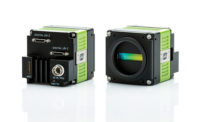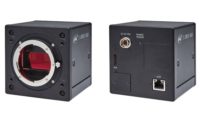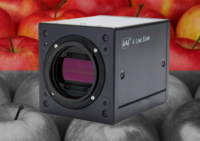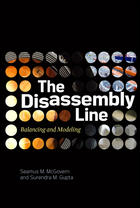JAI has introduced a new 3-CMOS prism color line scan camera in its Sweep+ Series camera family. The new SW-4000T-MCL features three custom CMOS line sensors with 4K (4096 pixels) resolution, mounted on a high-grade optical prism assembly that precisely splits the incoming light into red, green, and blue wavebands.
The new camera provides 24-bit non-interpolated RGB output at up to 67.7 kHz (67,700 lines per second), which is more than four times faster than any previous 4K prism color line scan camera, making it one of the fastest 4K color line scan cameras of any type – trilinear or prism-based.
The increase in line rate means that designers of color line scan-based inspection systems do not have to sacrifice speed for image quality if their application requires higher color and spatial precision than can be provided by trilinear cameras.
To support its high-speed operation, the SW-4000T-MCL features three custom CMOS imagers with 7.5-micron square pixels, offering high responsivity for the short exposure times needed at maximum line rates.
In addition, each of the three CMOS sensors has two adjacent lines. This arrangement makes it possible for the SW-4000T-MCL to provide horizontal binning, vertical binning, or both. Furthermore, the sensor’s readout architecture combines the readout of two pixels through a single diffusion node to double the signal without increasing noise, enabling the binning process to dramatically increase sensitivity. This advanced binning capability was introduced on JAI’s 4K trilinear camera (SW-4000TL-PMCL) earlier this year, and remains unique to JAI.
Another line scan feature found only in JAI’s 4K color cameras is the built-in color conversion capability that allows the SW-4000T-MCL to provide native HSI or CIEXYZ color output, in addition to offering conversions from standard RGB to the sRGB or Adobe RGB color spaces, or even to a user-defined custom RGB conversion matrix.
For encoder connection, the SW-4000T-MCL features four separate input lines plus built-in algorithms to support direct connection from up to two rotary encoders. This means users do not have to connect the encoder via the frame grabber, simplifying the cabling and reducing the possibility of lines being dropped due to issues between the frame grabber and the camera. Of course, the camera’s Camera Link interface can still be used to make the encoder connection in the traditional way, if that is what the user prefers.
Additional standard features include gain and black level adjustment, manual or automatic white balancing, shading correction, PRNU and DSNU correction, and chromatic aberration compensation.
The SW-4000T-MCL utilizes a GenICam and Gen-CP-compliant Camera Link interface with Mini CL connectors to output line data. Base, Medium, Full, or Deca configurations are supported, depending on the bit depth and line rate required. 3 x 8-bit and 3 x 10-bit output can be selected.
In addition to the Camera Link interface, a 12-pin Hirose connector and a 10-pin auxiliary connector are provided with a total of three TTL inputs, one opto-isolated input, and four TTL outputs.
The camera can be ordered with two different lens mount options – a Nikon F-mount or an M52 mount.
JAI








